|
市場調查報告書
商品編碼
1783022
工業機器人的數位&AI:2025年Digital & AI in Industrial Robotics Insights Report 2025 |
|||||||
樣品預覽
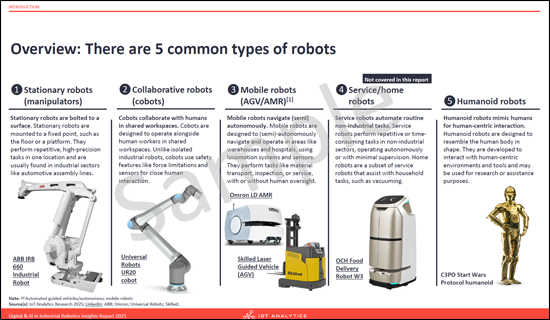
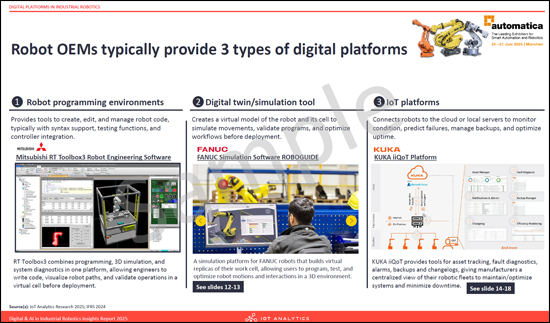
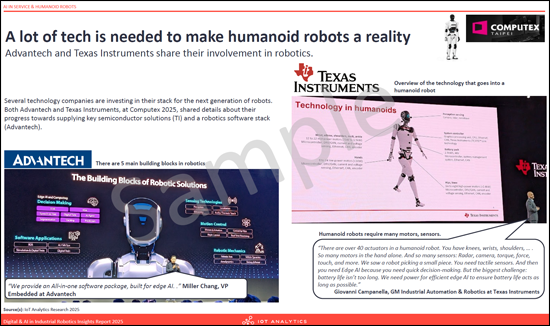
隨著軟體平台和人工智慧的進步重新定義自動化功能,工業機器人領域正在經歷重大技術變革。對於製造、自動化和技術開發領域的領導者來說,準確、及時地了解這些趨勢對於制定策略規劃和保持競爭優勢至關重要。
本報告分析了機器人領域數位平台和人工智慧的最新趨勢,這是工業物聯網和人工智慧持續研究的一部分。本報告是根據在德國慕尼黑舉行的Automatica 2025展會上進行的50多次訪談以及一些二手資料。
樣品預覽
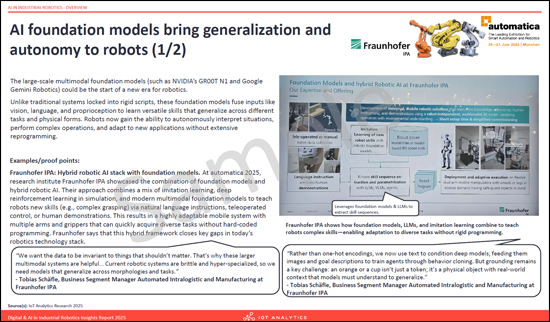
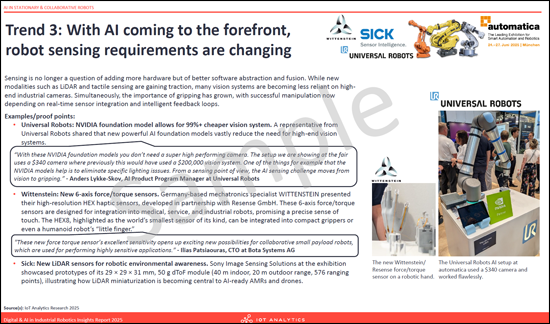
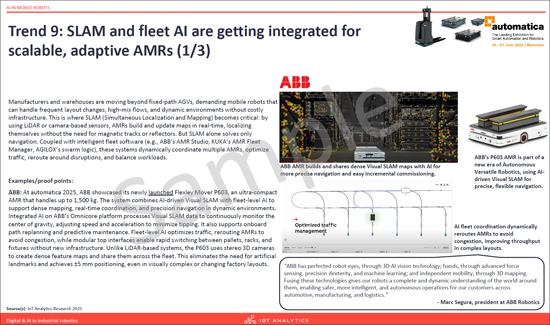
報告概述
- 58頁PDF報告:一份詳細的文檔,分析了最新的機器人趨勢。
- 十大關鍵趨勢分析:回顧機器人領域數位平台和人工智慧領域最重要的發展。
- 三家原始設備製造商 (OEM) 的詳細比較:詳細比較領先供應商的物聯網平台、人工智慧配置和移動機器人產品。
- 訪談 50 多位專家的見解:在 Automatica 2025 展會上展示來自機器人原始設備製造商 (OEM)、新創公司和整合商的直接觀點。
- 五種機器人類型的細分:概述固定式、協作式、移動式、服務式和人形機器人的角色和市場格局。
樣品預覽
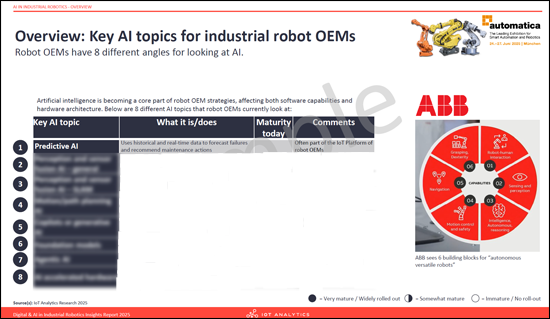
被言及了的企業
用本報告被言及的企業的一部分:
|
|
目錄
第1章 簡介
第2章 工業機器人的數位平台
第3章 工業機器人的AI
- 概要
- 固定式和協動型機器人的AI
- 移動機器人的AI
- 服務的AI和類人型機器人
第4章 關於IoT Analytics
A 58-page report analyzing the current state and future vision for software platforms and AI in industrial robotics - based on observations and 50+ expert interviews.
Sample preview



Introduction
The industrial robotics landscape is undergoing a significant technological shift as advancements in software platforms and artificial intelligence redefine automation capabilities. For leaders in manufacturing, automation, and technology development, a current and objective understanding of these trends is critical for strategic planning and maintaining a competitive edge.
As part of our ongoing coverage of industrial IoT and AI, this report presents a timely analysis of the state of digital platforms and AI in robotics. The insights are based on observations and over 50 interviews conducted at Automatica 2025 in Munich, Germany, supplemented by selected secondary research.
The result is a 58-page report compiled to help readers stay apprised of the newest trends in industrial robotics and the evolving market landscape. The report examines the software strategies of leading OEMs and provides a deep dive into the key use cases and technologies driving the next generation of industrial automation.
Sample preview



Report at a glance
- 58-page PDF report: A detailed document analyzing the latest robotics trends.
- Analysis of 10 key trends: A review of the most important developments in digital platforms and AI for robotics.
- 3 in-depth OEM comparisons: Detailed examinations of the IoT platforms, AI setups, and mobile robot offerings from leading vendors.
- Insights from 50+ expert interviews: Direct perspectives from robotics OEMs, startups, and integrators at Automatica 2025.
- Breakdown of 5 robot types: An overview of the roles and market status for stationary, collaborative, mobile, service, and humanoid robots.
Sample preview

Key areas of analysis:
The report's analysis includes an in-depth look at several key areas:
- OEM digital platform strategies: An examination of the three types of software platforms offered by robot OEMs: programming environments, digital twin/simulation tools, and IoT platforms. The analysis includes a detailed comparison of the IoT platform offerings of leading vendors.
- The role of AI in robotics: A deep dive into the key AI topics for industrial robot OEMs, including perception, motion planning, and the emerging role of foundation models. The report includes detailed comparisons of the AI setups of leading stationary and mobile robot manufacturers.
- Emerging technology trends: An analysis of 10 key trends observed at Automatica 2025.
- Market overview and context: An analysis of the global industrial robotics market, including annual installation data by country, industry, and vendor.
A data-driven foundation for key business functions
This research is designed to provide a data-driven foundation for key business functions:
- For corporate strategy & product management: The report's analysis of OEM platform strategies and emerging technology trends provides the necessary intelligence to benchmark product roadmaps and identify new market opportunities.
- For CTOs & engineering leadership: The deep dives into AI hardware and software architectures, including the role of AI compute and changing sensor requirements, offer a clear view of the technological trajectory of the industrial robotics market.
- For market intelligence & competitive analysis: The detailed comparisons of vendor offerings in IoT platforms and AI serve as a central, objective source of intelligence for assessing the competitive landscape.
- For automation & manufacturing leaders: The analysis of key use cases and trends provides a practical guide to the latest advancements in robotic automation, from virtual commissioning with digital twins to the adoption of AI-driven quality control.
Key concepts in industrial robotics
Types of robots
The report provides context on the five common types of robots in the market:
- Stationary robots: Robots mounted to a fixed point, typically used for repetitive, high-precision tasks in industrial settings.
- Collaborative robots (cobots): Robots designed to operate safely alongside human workers in shared workspaces.
- Mobile robots (AGV/AMR): Robots that navigate (semi)-autonomously to perform tasks like material transport and inspection.
- Service robots: Robots that automate routine, non-industrial tasks in sectors like healthcare and logistics.
- Humanoid robots: Robots designed to resemble the human body for interaction in human-centric environments.
OEM software platforms
The analysis covers the three core types of digital platforms that robot OEMs typically provide:
- Robot programming environments: Tools to create, edit, and manage robot code.
- Digital twin/simulation tools: Software to create virtual models of robots and their work cells for offline programming and validation.
- IoT platforms: Software to connect robots to the cloud or local servers for condition monitoring, predictive maintenance, and fleet management.
Questions answered:
- What types of robots currently exist, and what are their roles?
- What types of software platforms do robotics OEMs provide?
- How many robots have been installed, and which industries and regions lead in these installations?
- What are key focus areas of AI in robotics and how do they differ among robotic OEMs?
- What are robotics executives saying about the current and future states of robotics?
- What are key use cases for AI in robotics?
- How do IoT platforms of different robotics OEM compare?
Companies mentioned:
A selection of companies mentioned in the report.
|
|
Table of Contents
1. Introduction
2. Digital platforms in industrial robotics
3. AI in industrial robotics
- Overview
- AI in stationary & collaborative robots
- AI in mobile robots
- AI in service & humanoid robots






